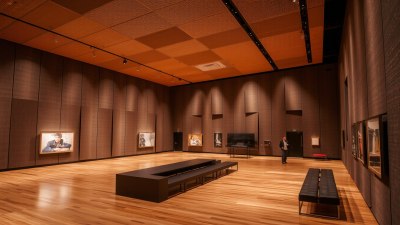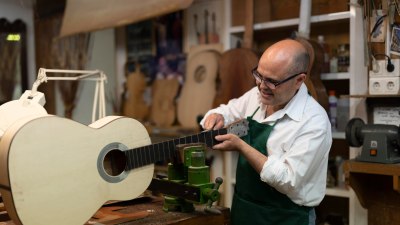The Rooms That Swallow Sound in Minneapolis
Explore Minneapolis's unique sound-dampening rooms and their architectural significance.

Minneapolis, known for its vibrant culture and rich architectural diversity, is home to countless venues that offer not just visual aesthetics but also intriguing acoustic properties. Among them, there exists a subset of spaces characterized by their ability to absorb sound, creating an enveloping auditory experience that is both captivating and essential for various functions. These rooms, designed with specific acoustic treatments and materials, present fascinating insights into the art of sound design and architectural engineering.
One of the first places to consider when discussing sound-absorbing rooms in Minneapolis is the renowned Walker Art Center. This contemporary art museum is famous not just for its impressive collection but also for its carefully designed exhibition spaces. The museum incorporates features such as soft wall panels and suspended acoustic ceilings that help to minimize echoes and reverberations. The design choices made by the architects, along with the selection of materials, create an ideal environment for the appreciation of visual art, allowing visitors to focus on the exhibits without the distraction of background noise.
Similarly, the Guthrie Theater stands out as a prime example of a venue designed with acoustic integrity in mind. The theater’s stunning architecture by Jean Nouvel includes a unique, cantilevered design that not only offers breathtaking views of the Mississippi River and Minneapolis skyline but also facilitates exceptional sound quality. The theater’s main stage, featuring advanced sound-dampening techniques, provides audiences with a remarkable auditory experience, making every performance a memorable one. The combination of materials used in the theater’s construction further enhances the acoustics, showcasing the importance of thoughtful design in the performing arts.
The use of sound-absorbing materials is not limited to just theaters and art museums. Educational institutions in the area, like the University of Minnesota, employ similar techniques in their lecture halls and auditorium spaces. These rooms often feature acoustic tiles, carpets, and strategically placed sound baffles aimed at creating an environment conducive to learning. The result is a significant reduction in unwanted noise, allowing students and educators to engage in discussions without excessive distractions. This thoughtful consideration of acoustics underscores the university's commitment to providing an optimal learning experience for its students.
In contrast to the more formal spaces previously mentioned, the city’s community centers also offer sound-dampening solutions that serve a diverse array of functions. For instance, the impacting design of the Minneapolis Recreation Center includes multi-purpose rooms where line dancers might practice or kids play games. The design incorporates soft flooring and wall treatments that absorb sound, ensuring that activities within the facility do not disrupt neighboring areas. Such centers play a crucial role in the urban fabric, promoting community engagement while prioritizing the acoustic comfort of those using the space.
Moreover, private establishments such as restaurants and cafes in Minneapolis are increasingly recognizing the importance of acoustics in enhancing the dining experience. Locations like the Birchwood Café, known for its locally sourced menu, have invested in sound-absorbing elements such as upholstered seating and acoustic panels that allow for lively conversations without overwhelming noise. This aspect not only improves customer satisfaction but also aids in creating a welcoming ambiance where conversations can flourish.
The convergence of sound and architecture is also explored in event spaces around the city. Venues designed for weddings, corporate events, and celebrations often take acoustic considerations into account during their design process. Spaces like Aria, with its blend of industrial elegance and strategic sound dampening, ensure that guests can enjoy music and speeches without competing with excessive noise levels from other aspects of the event. This attention to detail speaks volumes about the venue's commitment to providing an extraordinary experience for its clients.
Beyond structural adaptations, Minneapolis also hosts regular events and performances that highlight the significance of sound design. The Sound Unseen festival, for instance, focuses on audio-visual art, emphasizing the relationship between sound and environment. Such events provide an opportunity for artists and musicians to explore the dynamic interactions between their work and the acoustics of the spaces they inhabit. This ongoing dialogue not only reveals the depth of Minneapolis’s artistic community but also celebrates the city as a living laboratory for sound experimentation.
As technology advances, the future of sound in spatial design continues to evolve. Innovations in acoustics, including smart materials and sound-responsive installations, are poised to revolutionize how spaces are conceived and utilized. The integration of such technologies into architecture is already being explored in various developments across Minneapolis, paving the way for more responsive environments that adapt to the needs of their occupants.
Emphasizing the cultural fabric of Minneapolis, its sound-absorbing rooms and venues reflect a broader narrative about the interplay of architecture, community, and sound. The thoughtful consideration of how sound operates within a space not only enhances functionality but also contributes to the experiential quality of the environments we inhabit. As the city continues to grow and adapt, so too will its understanding and implementation of sound design principles, making Minneapolis an exciting case study in the realms of architecture and acoustics.
In conclusion, from the acclaimed Walker Art Center to the dynamic community spaces and eateries, Minneapolis is rich with rooms that swallow sound, designed with intent to enhance the auditory experience. These thoughtfully crafted environments underscore the intricate relationship between sound and space, highlighting the importance of acoustic considerations in various architectural contexts. As architects, sound designers, and community leaders collaborate to create spaces that resonate with the needs of their users, the future of sound in Minneapolis looks promising. Through continued innovation and appreciation for the arts, these sound-absorbing rooms will play a critical role in shaping the city’s vibrant cultural landscape for years to come.











